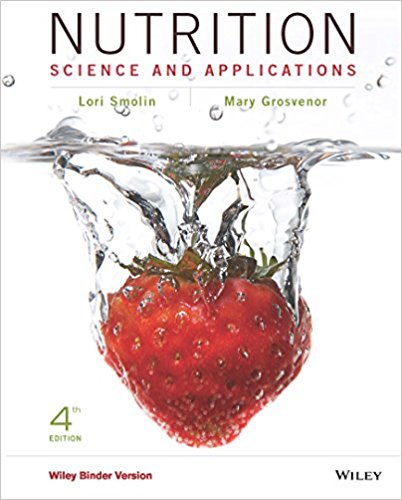Test Bank For Nutrition Science and Applications, Binder Ready Version, 4th Edition Smolin, Grosvenor
Digital item No Waiting Time Instant DownloadISBN: 978-1-119-22464-8, ISBN: 9781119224648
In Stock
Original price was: $75.00.$25.00Current price is: $25.00.
Test Bank For Nutrition Science and Applications, Binder Ready Version, 4th Edition Smolin, Grosvenor
Course Title: Smolin4e
Chapter Number: 3
Question Type: Multiple Choice
1) _________ are units of matter that cannot be further broken down by chemical means.
a) Organic compounds
b) Cells
c) Atoms
d) Solvents
Answer: c
Difficulty: Easy
Learning Objective: LO 3.1 Describe the organization of life and the organ systems that play a role in obtaining and using nutrients.
Section Reference: Section 3.1 Food Becomes Us
2) Nutrients classified as “organic molecules” have a molecular structure which contains the element:
a) carbon.
b) oxygen.
c) nitrogen.
d) sulfur.
Answer: a
Difficulty: Easy
Learning Objective: LO 3.1 Describe the organization of life and the organ systems that play a role in obtaining and using nutrients.
Section Reference: Section 3.1 Food Becomes Us
3) Which of the following sequences is organized from the simplest to the most complex arrangement?
a) atoms : molecules : tissues : organs
b) molecules : tissues : atoms : organs
c) tissues: atoms : molecules : organs
d) atoms : organs : tissues : molecules
Answer: a
Difficulty: Easy
Learning Objective: LO 3.1 Describe the organization of life and the organ systems that play a role in obtaining and using nutrients.
Section Reference: Section 3.1 Food Becomes Us
4) The movement of food through the digestive tract is regulated by:
a) the endocrine and nervous systems.
b) the lymphatic and muscular systems.
c) the respiratory and urinary systems.
d) the cardiovascular system.
Answer: a
Difficulty: Medium
Learning Objective: LO 3.1 Describe the organization of life and the organ systems that play a role in obtaining and using nutrients.
Section Reference: Section 3.1 Food Becomes Us
5) The most important roles of the digestive system include digestion and:
a) metabolism.
b) absorption.
c) circulation.
d) excretion.
Answer: b
Difficulty: Medium
Learning Objective: LO 3.2 Explain the gastrointestinal tract structure and the roles of mucus, enzymes, nerves, and hormones in the digestive tract.
Section Reference: Section 3.2 The Digestive System
6) The internal lining of the gastrointestinal tract is the:
a) submucosa.
b) serosa.
c) muscularis.
d) mucosa.
Answer: d
Difficulty: Easy
Learning Objective: LO 3.2 Explain the gastrointestinal tract structure and the roles of mucus, enzymes, nerves, and hormones in the digestive tract.
Section Reference: Section 3.2 The Digestive System
7) The digestive tract begins at the _________ and ends at the _________.
a) esophagus; small intestine
b) mouth; transverse colon
c) esophageal sphincter; pylorus
d) mouth; anus
Answer: d
Difficulty: Easy
Learning Objective: LO 3.2 Explain the gastrointestinal tract structure and the roles of mucus, enzymes, nerves, and hormones in the digestive tract.
Section Reference: Section 3.2 The Digestive System
8) Transit time is the rate at which food:
a) moves through the digestive tract.
b) is swallowed.
c) is absorbed into the blood.
d) is broken down into chyme.
Answer: a
Difficulty: Easy
Learning Objective: LO 3.2 Explain the gastrointestinal tract structure and the roles of mucus, enzymes, nerves, and hormones in the digestive tract.
Section Reference: Section 3.2 The Digestive System
9) Which of the following is NOT a product released by the GI tract?
a) Mucus
b) Enzymes
c) Chyme
d) Hormones
Answer: c
Difficulty: Easy
Learning Objective: LO 3.2 Explain the gastrointestinal tract structure and the roles of mucus, enzymes, nerves, and hormones in the digestive tract.
Section Reference: Section 3.2 The Digestive System
10) Which of the following is NOT an accessory organ of the digestive system?
a) Liver
b) Pancreas
c) Salivary glands
d) Kidney
Answer: d
Difficulty: Easy
Learning Objective: LO 3.2 Explain the gastrointestinal tract structure and the roles of mucus, enzymes, nerves, and hormones in the digestive tract.
Section Reference: Section 3.2 The Digestive System


Reviews
There are no reviews yet.